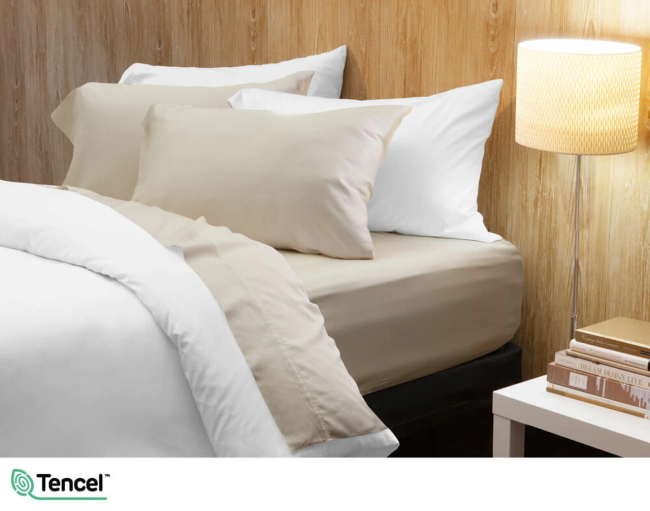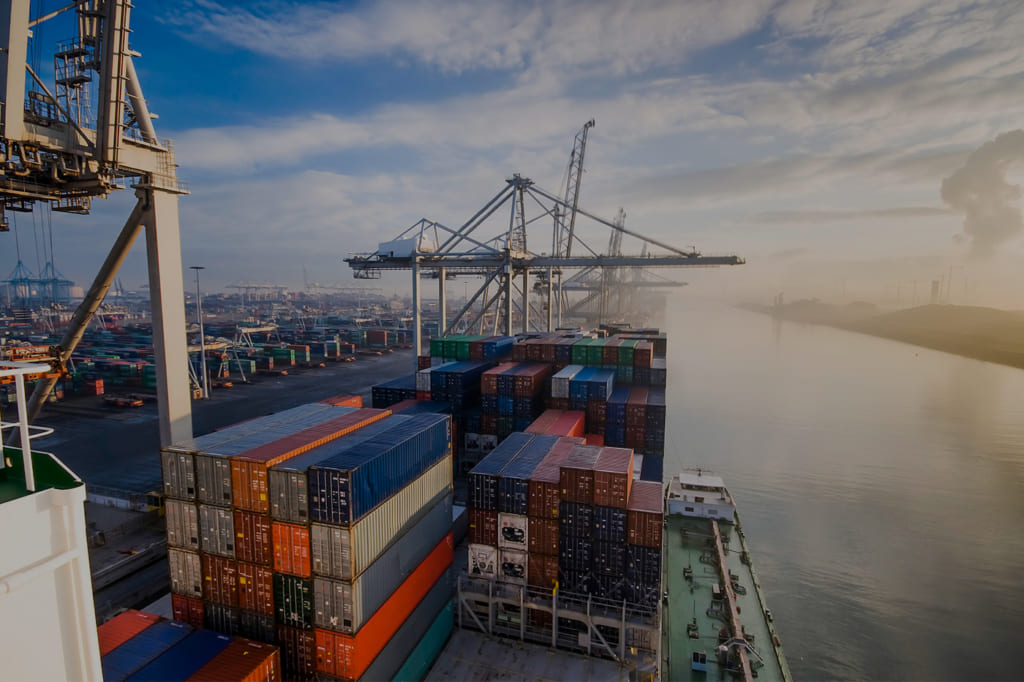What is Tencel?
Tencel is a branded version of the Manmade Cellulosic (MMC) fiber known as Lyocell. It is a registered trademark of the manufacturer called Lenzing. Its development in the 1980s was partially motivated by concern over environmental impacts associated with rayon, which also belongs to the group of MMC fibers. Tencel is similar to rayon but processed differently. Lenzing is a leading manufacturer of sustainable MMC fibers.
Manmade cellulosic fibers (MMC), including Viscose/Rayon, Lyocell, and Modal, are the second most important group of cellulosic fibers after cotton, and rapid growth is expected for this fiber group in the future.
MMC comes from plants, most often trees, which are chipped and processed into pulp before being processed into fibers. According to environmental not-for-profit Canopy, 150 million trees are cut each year for dissolving pulps, with approximately 1/3 coming from ancient and endangered forests.
Viscose/Rayon is the most common MMC, making up around 90% of MMC production. To transform wood pulp into fiber, the pulp undergoes a chemical-technological process that involves multiple steps. The process involves high use of chemicals, energy, and water. Highly toxic emissions can end up in the environment and harm not only factory workers but also local communities and animals. Lyocell is the second most common MMC. The solvent spinning technique for Lyocell fibers is both simpler and more environmentally sound as the process involves direct (physical) dissolution of cellulose pulp in an organic, biodegradable and aqueous solvent which is recycled in the manufacturing process.
Other MMC include Modal, Acetate, and Cupro.
Being from a renewable source and usually biodegradable, MMC is often seen as an attractive alternative to synthetic fibers based on non-renewable fossil raw material.
Preferred manmade cellulosic fibers (pMMC) are sourced from producers that have been verified as low risk of sourcing from ancient and endangered forests and are manufactured more sustainably than conventional products. Textile Exchange has selected pMMC as one of its lead fiber types to further develop best practices and scale commercial uptake and promotion. There is huge potential for more sustainable pMMC to gain a higher market share. Tencel is a Preferred MMC.
ATTRIBUTES
Tencel may be used for knits, shirting, activewear, denim, and other apparel applications. Its properties are similar to that of cotton and it is valued for softness and breathability. A very soft fiber, Tencel is also known for having an attractive drape, fluidity, and wrinkle resistance. It is highly dyeable and can be produced in vibrant colors. It may be blended with any natural or synthetic fiber to produce a variety of textiles and can be finished in many processes depending on the desired effect. It can be used as 100% Tencel textile or blended with cotton to produce a stronger textile, wool for a higher absorbent textile, rayon for better stability than 100% rayon, or with polyester or polyamide for functional sportswear.
Tencel does not attract static and has high absorbency, but has poor thermal retention. Apparel, sportswear, and home textile applications made with Tencel exhibit excellent comfort properties. Tencel is moderately resilient and can wrinkle. However, it maintains dimensional stability well and has superior elastic recovery to rayon and acetate. It may shrink when washed. Tencel is sensitive to abrasion when wet, which can result in pilling and a fuzzy texture that is undesirable on smooth fabrics, therefore it is recommended to dry clean or wash on a gentle cycle. Otherwise good durability and soft hand make Tencel long-lasting and attractive for apparel applications.
Characteristics
- Typically stronger than cotton
- Durable
- Very soft
- Very breathable
- Non-irritating on skin
- Reduced bacterial growth
- Strong dimensional stability
- Rapid and deep dyeing
MAKING
Material Sourcing
The basic raw material of Tencel is wood, typically from relatively fast-growing species such as eucalyptus, pine, and beech. Wood is sourced from plantations in multiple countries; some of which are certified to Forest Stewardship Council (FSC) standards and some to Programme for the Endorsement of Forest Certification (PEFC) standards. Trees are grown on cultivated plantations from seeds raised in large nurseries, often from cloning or vegetative propagation to ensure genetic similarity. Agricultural chemicals may be used in growing nursery stock, but plantations that provide wood fiber for Lenzing’s Tencel fiber are managed without synthetic pesticides or fertilizers. Once trees are mature, they may be clear cut or selectively harvested, though species such as eucalyptus will regenerate for two to three cycles after harvest without replanting.
Due to the mass of the harvest, pulping mills are often located nearby. Once harvested, the wood is mechanically debarked in the field or at the mill. Bark may be used for fuel, mulch, or returned to the soil. Debarked wood is fed into chipping machines and then processed in a digester usually using the acid sulfite process (bisulfite) to remove the lignin, resins, and most of the hemicellulose that binds the cellulose fiber; the kraft process (sodium sulfate and sodium hydroxide) typically does not reduce hemicellulose to desired levels. The resulting dissolving pulp is greater than 90% cellulose (specialty grades can be as high as 96%) and can be used for textiles, cellophane, tire cords, acetate production, and other applications. The pulp is then shipped to customers for use as an input material in the fiber production facility. Lenzing sources pulp for its Tencel products either from the market pulp in long-term contracts with selected suppliers or from its own pulp mills in Austria and the Czech Republic. Beechwood is transported via rail or truck to Lenzing’s pulping facility in Austria; spruce wood is supplied to the pulp factory in the Czech Republic. The market pulp is mainly eucalyptus sourced from the southern hemisphere which is transported to fiber production sites via transoceanic ship to fiber manufacturing in Asia and Europe.
Processing
The wood pulp is wetted out with a dilute amine oxide solvent typically NMMO (N-methyl morpholine-N-oxide), followed by evaporation of excess water to create a viscous cellulose dope for spinning. The dope solution is filtered to remove remaining intact pulp fiber and any inorganic compounds (sand, etc.). It is then extruded through multiple spinneret jets into an air gap where the fibers are drawn and cooled by a controlled gas flow before being sent through a dilute amine oxide spin bath where the solution coagulates (regenerates) into fiber. All the fibers from the spinneret (which may number in the thousands) are gathered into a single tow and washed in water to remove the solvent; the wash water is purified, and then reused in the spin bath system to maintain liquor concentrations. An estimated 99.5% of the solvent is recovered and recycled within the process.
Washed filaments receive softening and antistatic treatments and can be bleached as well. Following drying, the filaments are crimped and may then be cut into staple form for shipment to yarn mills. In staple form, Tencel is spun into yarn similar to cotton to produce yarns of various properties. As filament yarn, Tencel is smooth and uniform, and a relatively little twist may be imparted to improve the luster of the fabric.
Textile Construction
Tencel fibers have a relatively high tendency to fibrillate when wet; they peel into individual hair-like fibrils. Depending on the intended use, the fibrils may be enhanced to produce a particular aesthetic in the final textile or controlled to produce a smooth surface.
Tencel requires very little processing to prepare for weaving/knitting and finishing, as it has no contaminations and does not require bleaching. Dye uptake is high, reducing inputs into the dyeing process (Taylor, 2011).
Woven textiles are produced on looms that combine warp yarns with filling yarns to produce a stable fabric. The type of loom used in the weaving process determines the environmental impacts: water-jet looms have high water usage, though it is reclaimed, the fabric must be dried before storage, increasing energy consumption. Projectile looms are low energy, accounting for half as much energy as rapier looms, and a third as much as air-jet looms.
Knitting is done by machines that loop yarns together to create a more flexible textile. Knitting requires significantly less energy than weaving, with a 20 fold decrease in energy demand. Vibration, lint, noise, and energy are all lower on knitting machines than for weaving looms.
Tencel is much preferred to other types of MMC fibers such as Viscose/Rayon, due to much better environmental performance. Being from a renewable source and usually biodegradable, MMC fibers are often seen as an attractive alternative to synthetic fibers. It is however important to ensure that raw material comes from sustainable sources and safe chemical processing of the wood pulp. Lenzing is therefore a preferred supplier.
INS AND OUTS
Process inputs
Harvesting of European beech is done entirely by machine, which requires energy to operate. Eucalyptus for producing market pulp is mostly harvested by hand (80%) with the remainder harvested by machine.
Neither European beech nor spruce trees nor southern hemisphere eucalyptus trees use irrigation for cultivation. However, the process of pulpwood can be a water-intensive activity. Process water in the form of softened, deionized water or tap water accounts for 20 L/kg Tencel staple fiber production. Total water use from cradle to gate unfinished woven textile is estimated to be 265 L/kg, most of which is cooling water.
The European beech and spruce trees used to produce Tencel are not fertilized and have no chemical inputs, however, market pulp from eucalyptus may utilize small amounts of nitrogen and phosphate fertilizers. Caustic soda and sulfur dioxide are used to produce pulp. NMMO (N-methyl morpholine oxide) is used as the solvent for turning wood pulp into spinning dope. Other chemicals include the use of softeners and antistatic agents. Propyl gallate is used as a stabilizer with NMMO to minimize degradation in solvent recovery.
Eucalyptus trees grow quickly in dense stands on low-grade land, resulting in significantly less land intensity than cotton. Tree plantations for pulp can be established on nearly any type of land, including exhausted cropland or degraded and heavily logged areas. The trees used for Tencel are grown on marginal land that would not otherwise be used to produce food crops. The plantations used for eucalyptus as well as the beech and spruce forests maintained for the production of Tencel have been managed since before 1990 and are not considered the conversion of wildlands. Beech and spruce forests in Central Europe have been managed sustainably for centuries.
Process outputs
Wood grown for processing into pulp creates a co-product of bark, which has no economic value but may be used to amend the soil or as a fuel. Lenzing’s pulping process produces 39% pulp, 11% acetic acid, furfural and xylose, and 50% thick liquor and bio-sludge. This liquor and sludge is used for the recovery of pulping chemicals and combusted for energy production. The acetic acid, furfural, and xylose are all co-products that have various uses; acetic acid and xylose as food ingredients and furfural as a basic chemical for synthesis (e.g. in plastics production).
Pulp processing mills are known to produce effluent that is highly polluting, containing low biochemical oxygen demand (BOD), though most mills now treat their wastewater. Lenzing’s pulp mills and Tencel production plants have reduced their wastewater effluent to very low levels.
Efficient dye processes for Tencel result in higher uptake of color and reduced unfixed dye in wastewater.
The majority of Lenzing group’s energy usage comes from non-fossil fuels, with a companywide average of 52% and a site-specific sourcing of 83% non-fossil fuels, reducing their carbon emissions.
IMPACTS
Score In MSI
Lyocell, Modal, and Viscose/Rayon are all listed in the Base Materials of the Higg MSI. Their Generic scores range from 48 to 58, but if you customize the materials by swapping the ‘raw material source’ and ‘chemistry certifications’, you will see a very significant change in scores which clearly illustrate how important it is to source MMC fibers responsibly.
Example of Tencel
Generic Viscose/Rayon
OTHER CONCERNS
Potential Social and Ethical Concerns
Pulp produced from eucalyptus trees raises possible risks from monoculture plantations that may have potential impacts on biodiversity and deforestation of natural habitat, as well as cause soil erosion and nutrient loss. These are often located in developing tropical countries due to low costs of land, laxity of environmental regulations, and ideal growing conditions. Monoculture plantations face higher risks from disease and pests and may require chemical control. Plantations may reduce harvest pressure on natural forests and land-use intensity. There are also concerns over the displacement of people, and impacts on local populations from pesticide application. Risks associated with pulp used by Lenzing are minimized by sourcing forest products that are 100% certified or controlled according to FSC and PEFC standards.
Availability Of Material
Tencel is widely available in Europe, the U.S., and Asia. The Tencel brand is owned by Lenzing and licensed to manufacturers that meet their requirements when a chain of custody can be assured.
Availability Of Certified Material
Tencel fiber is available with Forestry Stewardship Council (FSC) and the Programme for the Endorsement of Forest Certification (PEFC) certification. All Tencel fiber is certified to Oeko-Tex Standard 100 to be free of harmful substances and has received the European Eco-Label.
#MATERIAL SNAPSHOTS
This post series #Material Snapshotsshares a curated mix of Textile Exchange’s Material Snapshots and Materials Summaries, for free. To access all available information, visit Textile Exchange, where full pdfs detailing every material can be bought.
Textile Exchange’s Material Snapshots and Materials Summaries are a set of tools designed to help the reader understand why the choice to use certain materials makes a difference in the textile, apparel, and footwear industry. That choice could result in positive or negative impacts depending on the material and supply network details. These snapshots and summaries can help brands make decisions on which preferred fiber or material is the right choice for them by providing a concise look at the raw material options, including agricultural processes, social impacts, and processing differences that make material sustainability profiles different. They also provide information on material properties, certifications, and sourcing information since sustainability is only one of the many reasons why a particular material is chosen.
The two sets of resources – the Material Summaries and the Material Snapshots – are designed to be used alongside each other within an organization to help educate and enable informed, intelligent fiber and material choices. The Material Summaries are geared more towards the designer/developer user in the company, whereas the Material Snapshots are designed for more technical users such as materials, sourcing, and sustainability professionals.
Read more: https://vnpolyfiber.com/everything-about-cupro-tencel-lyocell-modal/





